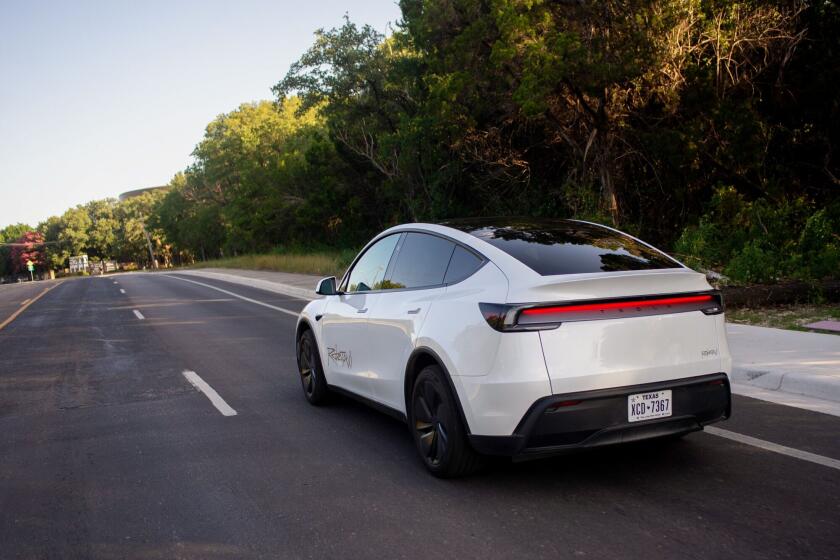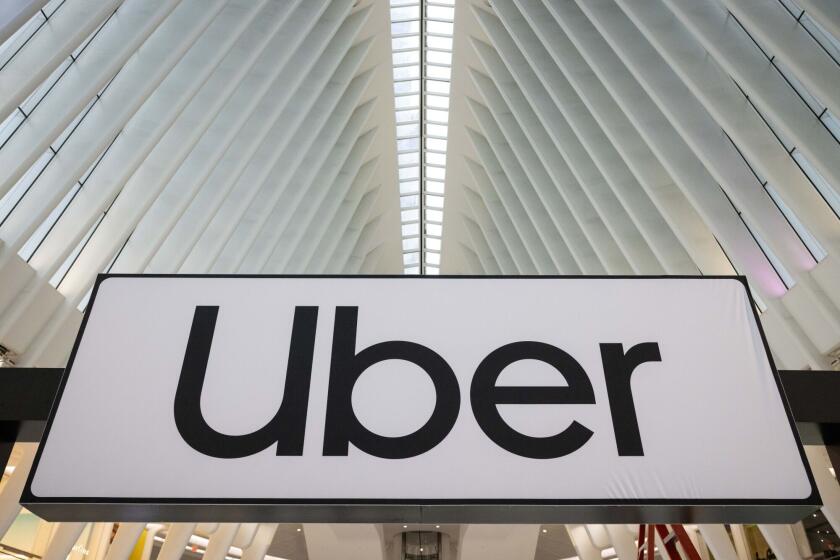LAX paparazzi regulars frown on the Russell Brand incident
- Share via
The entrance to the Delta terminal where actor Russell Brand was arrested recently in the latest bout of Hollywood versus paparazzi had regained its gritty anonymity on an afternoon last week. Travelers rolled bags over the spot where the actor confronted a throng of tabloid photographers, and a tired-looking man stopped there only long enough to stamp out a cigarette.
The swarm of camera-wielding men who surrounded Brand and his fiancée, singer Katy Perry, had moved on — there was Lindsay to chase in Santa Monica, Paris in Las Vegas — but down the sidewalk and around a bend, a small core of photographers, the airport regulars, persisted, their quiet, almost-invisible work dependent on tactics more cat and mouse than mob scene.
“Just got LeAnn Rimes,” paparazzo Edwin Blanco said as he leaned against a stairway overlooking the drop-off area for American Airlines first-class pas- sengers. Below, travelers climbed out of taxis and limousines, oblivious to Blanco and three other paparazzi nearby whose intense eyes and lumpy shoulder bags were the only indications of their profession.
“This has been my headquarters, my home,” said Tony Vera, a veteran airport videographer who kept his eyes on the car doors and his hands on a black gym bag concealing a camera. He spotted a man in a hat and sunglasses exiting a black SUV and paused. “Is that Pete Wentz?” he said. “No. Not him.”
For the small group of paparazzi who regularly work the airport — photographers put the number between four and 15 — the Brand fracas is an aberration, an intrusion of outsiders into one of the paparazzi world’s more orderly and civilized realms.
“None of the photographers surrounding Russell Brand and Katy Perry were airport photographers,” said Frank Griffin, whose agency, Bauer-Griffin, has a photographer assigned to LAX. Airport regulars “stick to the law. They don’t leave their cars parked in a no-parking zone and they don’t try to offend the celebrity apart from taking a photo.”
Perry wrote on Twitter that Brand was trying to protect her from a photographer shooting up her skirt, and while the workaday paparazzi at the airport are skeptical (“There’s no market for a shot like that,” one said), they regard “gangbangs” — the least offensive term they use to describe a crush of photographers — as essentially stupid.
“A lot of guys who are very seasoned won’t even go to a gangbang,” said Erik Crown, a former TMZ videographer who worked the airport for a year and a half. When 40 lenses are trained on one subject, no one is going to get paid very much, photographers said.
“Everyone’s trying to eat,” said Blanco, a 24-year-old college student who works for the agency Flynet.
The scrums develop when photographers outside the airport get a tip and share it with colleagues and competitors or when a group of photographers follows celebrities from their homes to the airport. The mobs are rare. Airport police Sgt. Belinda Nettles said officers respond to calls for crowd control involving the paparazzi “maybe once a month, twice a month” — not often, considering that airport officials estimate about 60 celebrities pass through LAX every day.
To track down famous faces in the enormous airport, the LAX paparazzi often rely on tips. Some come from publicists trying to drum up coverage, and some are bought with a $20 bill — or in the case of an A-list tip, a few bills — from limo drivers, fellow passengers or airport workers.
“We have a variety of sources. Some work for the airport. Most do not. And you’ve got to remember that it’s not always so sophisticated. It can be a sanitation worker that sees Kate Hudson” board a flight, said Ben Evenstad, the owner of the agency National Photo Group, which stations a photographer at the airport every day.
Asked about the practice of tipping off photographers, airport spokeswoman Nancy Castles said airport employees do not have flight information about individuals and that those who work for airlines could be violating international aviation regulations governing the release of names on passenger manifests.
Airport duty means a smaller, more comfortable world for a photographer than regular paparazzi work, which can stretch from Malibu to downtown courthouses. Food and restrooms are always available, and there are no car chases.
“It’s like going to work in an office. You get the flight schedules, you get tips from your bosses. It’s the same every day,” said former paparazzo Jennifer Buhl, who worked at the airport occasionally and is now writing a memoir about her career.
Crown, the former TMZ shooter, said airport interactions with celebrities were more pleasant than those that involved chasing them outside Hollywood restaurants or on the beach in Malibu. “You get 20 or 30 seconds to talk to them, and usually they are friendly and in good spirits,” he said.
But airport work pays significantly less, photographers said. Vera said he cut back on his airport work after a November encounter with Mike Tyson at LAX that left him bloody. (Authorities declined to charge either man.) He said he found he could make double the money by stationing himself outside the homes of tabloid staples such as Lindsay Lohan and Jesse James.
“The airport is a great place to work, but you can make a lot more money doorstepping,” Vera said.
Blanco said he makes about $3,000 a month plus commissions on photo sales.
“It’s less stressful [at the airport], but it is still very stressful,” Blanco said as he eyed a black Range Rover pulling up to the curb.
If tips are scarce, photographers make their own luck by “fishing” — strolling the terminal baggage claims and entrances for shots. Airport paparazzi scour crowds less for actual famous people than for signs that actual famous people are about to appear. A shiny black Escalade with tinted windows. A muscle-bound man with an earpiece. And, above all, the “star greeter,” hired by movie studios and other companies to whisk VIPs through lines. Airport photographers tend to memorize the greeters’ faces, walks, wardrobes and client lists.
On a recent afternoon, Vera, 51, was prowling the Bradley terminal when he spotted a greeter by the curb.
“He’s the biggest greeter in the airport. We may have struck gold,” he said.
It had been a so-so day so far. He’d happened upon Helen Hunt over by American Airlines. “This won’t sell now, but who knows? Maybe some day,” he said of the video of the actress. He had a tip that an “American Idol” judge would be touching down later in the afternoon. But the greeter at the curb suggested a massive star.
“My heart starts pounding. It’s the most incredible feeling,” he said.
Ten minutes later, a black SUV pulled up. The greeter opened the door, and Vera gripped the bag holding his camera. Out stepped a portly bald man with glasses. Vera’s shoulders slumped.
“That’s nobody. Maybe a writer or something. Nobody,” he said, crestfallen.
harriet.ryan@latimes.com
Sponsored Link: Amazon’s Russell Brand Page
More to Read
Inside the business of entertainment
The Wide Shot brings you news, analysis and insights on everything from streaming wars to production — and what it all means for the future.
You may occasionally receive promotional content from the Los Angeles Times.











